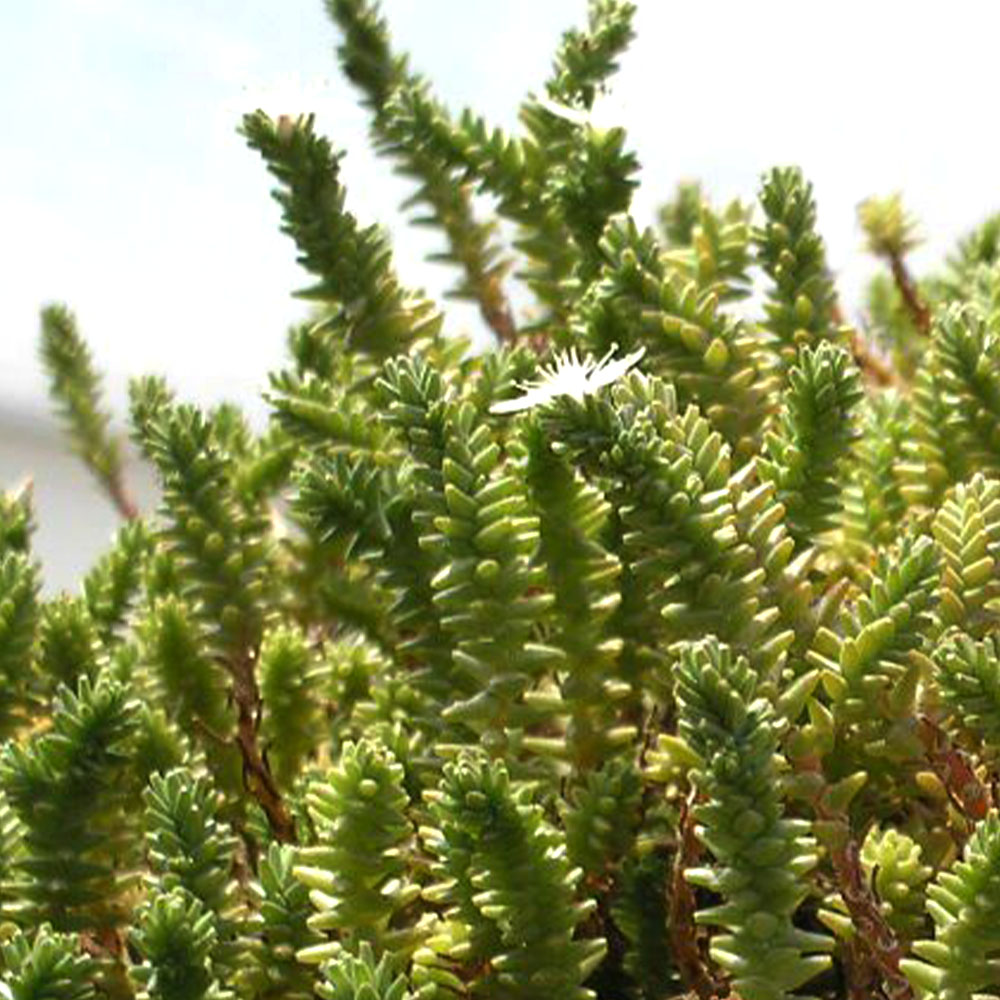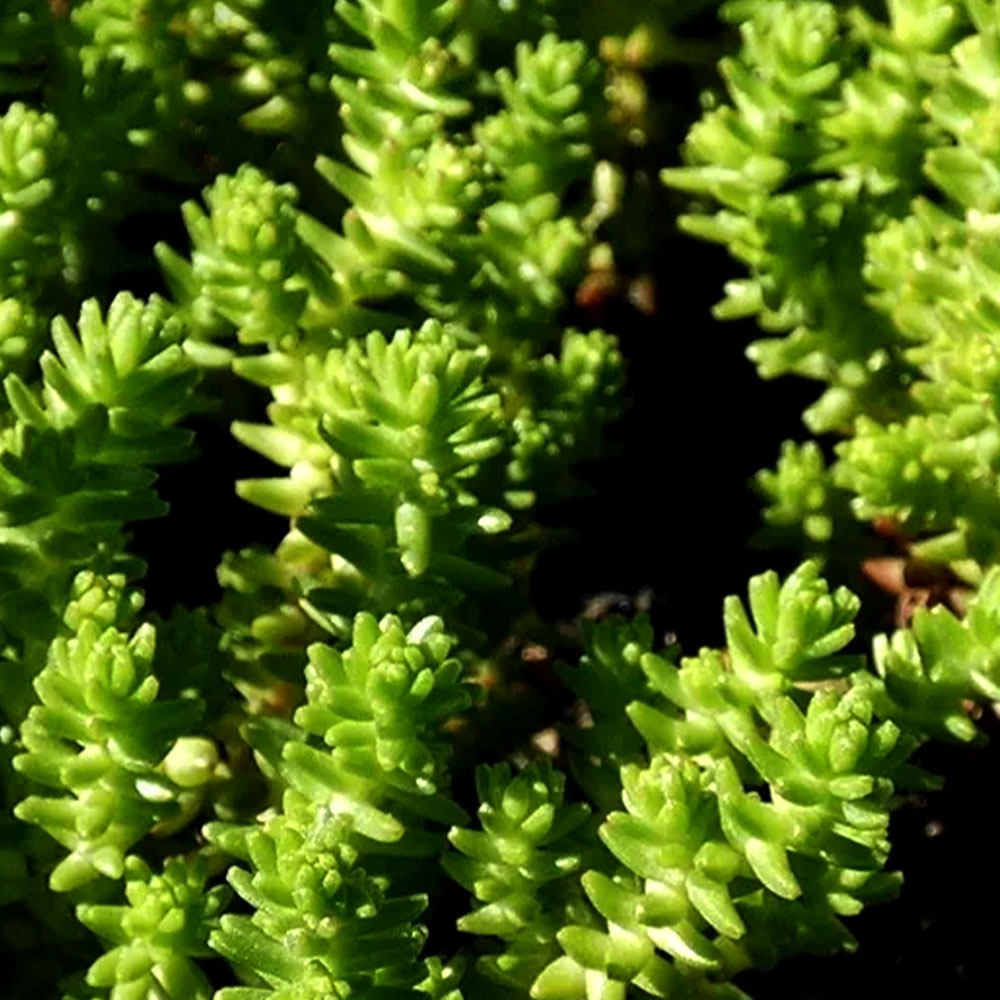-
 4,90 € × 1×€4.9
4,90 € × 1×€4.9
Customer matched zone "Locations not covered by your other zones"
“Sedum moranense” has been added to your cart. View cart
Sedum moranense
A heather-like ground cover with delicate star shaped flowers
Rated 0 out of 5
0 customer reviews
4,90 €
Only 20 item(s) left in stock!
Tags: couvre sol, feuillage persistant, graphique, secheresse, soleil, toits vegetalisés, vivace, xeriscaping
SKU: pda339
Category: Balcony-Friendly, Bees and Butterflies, Evergreen, Frost Hardy, Ground Cover, Make it Pop, Rewild, The Stunners

Sedum moranense
4,90 €
Only 20 item(s) left in stock!
Sedum moranense is a ground covering, heather-like succulent that is well-suited for rock gardens, dry slopes, or green roofs.
The leaves are heather-like, tiny, thick and cylindrical. They are arranged in a spiral pattern which is just stunning when you observe it up close – like little pine trees.
-
- In cold weather or dry conditions, the evergreen foliage turns a vibrant cherry red.
The pearl colored star-shaped flowers are minuscule, contrasting beautifully against the jet black anthers, and appear in the summer in summer.
-
- The plant’s flowering cycle is triggered by winter cold.
Unlike most hardy sedums, this species has a more upright growth habit, owing to a dense mass of fine, upright, and highly branched stems.
This succulent thrives in gravelly, mineral-rich soil with excellent drainage, making it extremely hardy and resistant to winter moisture. It is adaptable to various soil pH levels and prefers full sun to partial shade. Sun exposure enhances its reddish coloration in response to cold.
👨🌾GARDENING TIPS👨🌾:
-
- 🌱 Plant in spring (after the last frost) or late summer.
- 👵 As the plant matures, older stems will lose their leaves > do not worry, it will bring an even more heathery feel to the plant.
- 💡Layering Technique : it is useful to lay the longer stems on the soil directly as this will trigger the plant to produce roots at various points, encouraging a quicker assimilation into its new environment.
- 💡Propagation: Stem cuttings, planted directly into the ground from May to August (if you need a hand, just shoot us a message and we’ll show you!)
- Pair with other Sedums to create a lovely drought-resilient arrangement: Sedum pachyclados, Sedum tetragona, Sedum reflexum ‘Glaucum’
Learn more about caring for your Sedum:
The Tales & The Botany: Sedum moranense
Genus name comes from the Latin word sedeo meaning to sit in reference to the general growing habit of many of the sedums (they sit and sprawl over rocks). Living the easy life they are.
“Moranense” probably refers to its geographical origin. It seems to be derived from “Morán”, indicating a location in Mexico where the plant was first identified or is commonly found. Again, probably maybe and perhaps.
🌸 Floral Morphology: Sedum moranense
This species produces small, star-shaped flowers, typically yellow or pale yellow, which appear in terminal clusters from late spring through summer.
The flowers attract bees and other pollinators, adding ecological interest to garden spaces.
The leaves are slightly elongated and form tight rosettes, maintaining an attractive structure even when the plant is not in bloom.
🌱 Reproductive Biology
Sedum moranense reproduces both sexually through seeds and vegetatively through stem or leaf cuttings.
While its hermaphroditic flowers are insect-pollinated, vegetative propagation is commonly used to maintain uniformity in cultivated specimens.
Over time, the plant can form dense mats or clumps depending on the growing conditions.
🌍 Ecology & Adaptations
Native to dry environments, it thrives in well-drained sandy or rocky soils under full sun to partial shade.
The succulent leaves store water, helping the plant survive prolonged dry periods.
While tolerant of mild frost, excessive moisture or poorly drained soils can lead to root rot.
Its compact form and adaptability make it a versatile choice for rockeries, alpine-style plantings, xeriscaping, and container displays.
Other Names:
Red stonecrop
Origin:
Mexico and Texas
| Weight | 0,5 kg |
|---|---|
| Flower Color | 🩷 Pink |
| Flowering | July, August, September, October |
| Frost Tolerance | -10°C to -15°C |
| Exposure | Full Sun |
| Soil | Dry, Well-Draining, Rocky/Well-Draining |
| Size | 0.1m H x 0.6m W |
Reviews
0
Rated 0 out of 5
0 customer reviews
5
0
4
0
3
0
2
0
1
0
Only logged in customers who have purchased this product may leave a review.
You may also like…
Sedum kamtschaticum
A multi-colored sedum from the volcanic soils of the Kamchatka Peninsula
A multi-colored sedum from the volcanic soils of the Kamchatka Peninsula
Rated 0 out of 5
Sedum spurium
A plant used particularly for its ability to form attractive ground covers quickly.
A plant used particularly for its ability to form attractive ground covers quickly.
Rated 0 out of 5
Sedum pachyclados
Dainty green/gray/green succulent with rosettes and a creeping stem that can either spread or cascade.
Dainty green/gray/green succulent with rosettes and a creeping stem that can either spread or cascade.
Rated 0 out of 5
Related Products
Euphorbia myrsinites
Known for its draping form of silver-gray foliage and radiant blooms.
Known for its draping form of silver-gray foliage and radiant blooms.
Rated 0 out of 5
Tradescantia Blushing Bride
Gorgeous blushes of pink and white that appear in the coldest nights.
Gorgeous blushes of pink and white that appear in the coldest nights.
Rated 0 out of 5
Hellebore argutifolius
Winter flowering perennial with marbled blue-green leaves
Winter flowering perennial with marbled blue-green leaves
Rated 0 out of 5
Echinacea purpurea
A perennial with purple flowers all summer long
A perennial with purple flowers all summer long
Rated 0 out of 5
Trachelospermum asiaticum ‘Ogon Nishiki’
Jasmine with colorful foliage and lovely white flowers in summer
Jasmine with colorful foliage and lovely white flowers in summer
Rated 0 out of 5
Stachys byzantina
Silky white-grey leaves and tall striking flowers
Silky white-grey leaves and tall striking flowers
Rated 0 out of 5
Cerastium tomentosum var. columnae
A grey-green spreading ground cover from the mountains.
A grey-green spreading ground cover from the mountains.
Rated 0 out of 5
Mentha x piperita ‘Chartreuse’
A spicy mint, known for its use in the production of liqueurs and herbal teas.
A spicy mint, known for its use in the production of liqueurs and herbal teas.
Rated 0 out of 5
Tanacetum densum subsp amani
A shrublet composed of soft, finely divided silvery gray-white leaves.
A shrublet composed of soft, finely divided silvery gray-white leaves.
Rated 0 out of 5
Hieracium maculatum Leopard
A native perennial with blue-green leaves and a tall yellow flower
A native perennial with blue-green leaves and a tall yellow flower
Rated 0 out of 5
Euphorbia cyparissias Clarice Howard
A Euphorbia that resembles a soft little cyprus tree
A Euphorbia that resembles a soft little cyprus tree
Rated 0 out of 5
Sedum album
A low, multi-color ground cover.
A low, multi-color ground cover.
Rated 0 out of 5
Glechoma hederacea
A sweet smelling ground cover, producing little blue flowers all summer long.
A sweet smelling ground cover, producing little blue flowers all summer long.
Rated 0 out of 5
Delosperma cooperi
A dwarf perennial known for its vermillion colored flowers
A dwarf perennial known for its vermillion colored flowers
Rated 0 out of 5
Erigeron kavinskianus
A daisy-like carpet of flowers
A daisy-like carpet of flowers
Rated 0 out of 5
Artemisia Valerie Finnis
A semi-evergreen, aromatic variation on the theme of Artemisia.
A semi-evergreen, aromatic variation on the theme of Artemisia.
Rated 0 out of 5
Melissa officinalis
A perennial plant in the mint family that is adored by bees, royal families and tea drinkers.
A perennial plant in the mint family that is adored by bees, royal families and tea drinkers.
Rated 0 out of 5
Vinca minor
Looping elegance and ability to form a low flowering ground cover
Looping elegance and ability to form a low flowering ground cover
Rated 0 out of 5
recent view product
Aloe vera
A succulent known for the unctuous gel hidden in its leaves
A succulent known for the unctuous gel hidden in its leaves
Rated 0 out of 5
Leonotis leonurus
Known for its magnificent orange flowers and fragrant leaves
Known for its magnificent orange flowers and fragrant leaves
Rated 0 out of 5
Pycnanthemum verticillatum
A mountain mint from the eastern United States.
A mountain mint from the eastern United States.
Rated 0 out of 5
Artemisia absinthium
A highly fragrant, medicinal and striking grey-green bush with yellow flowers.
A highly fragrant, medicinal and striking grey-green bush with yellow flowers.
Rated 0 out of 5
Chrysanthemum Dernier Soleil
A perennial with large yellow flowers tipped with coppery-orange hues
A perennial with large yellow flowers tipped with coppery-orange hues
Rated 0 out of 5























































There are no reviews yet.